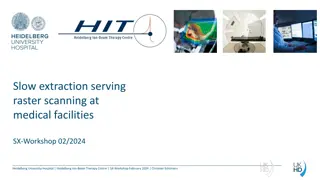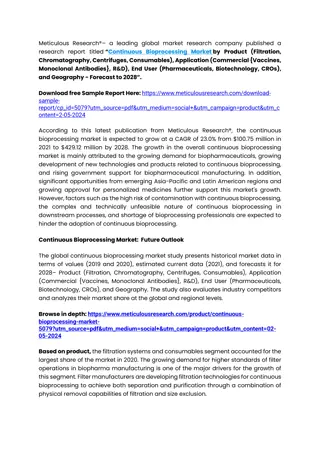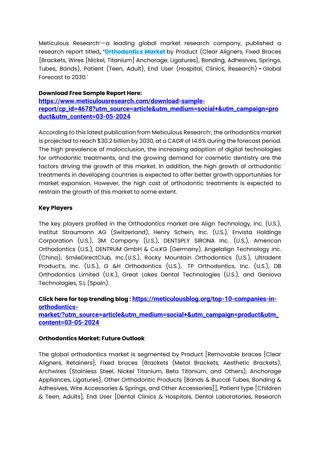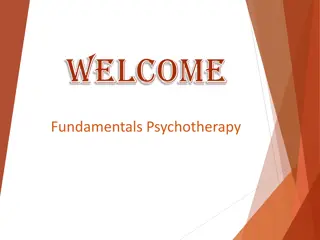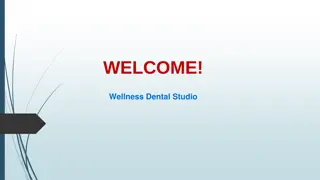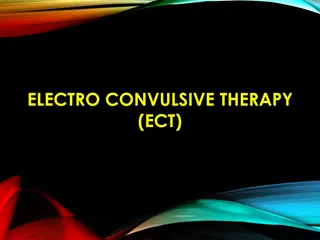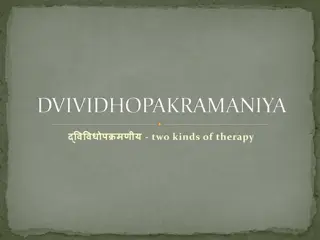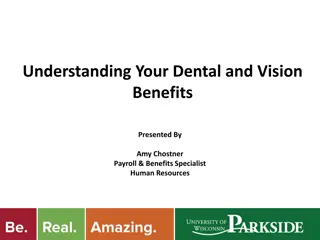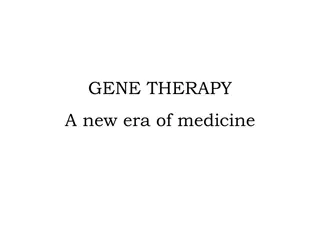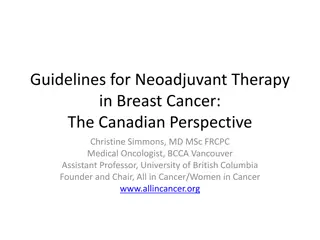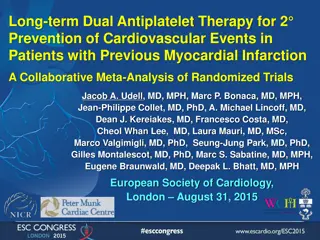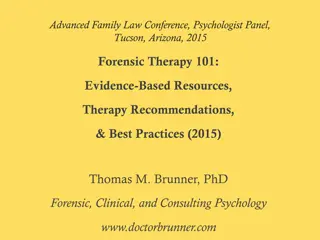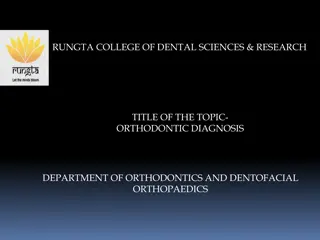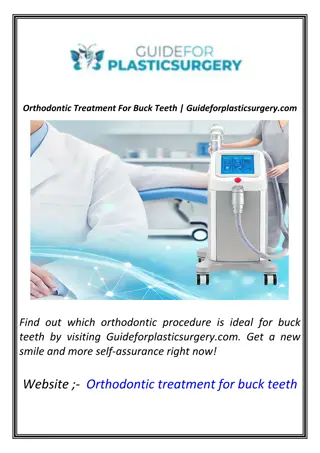Adjunctive Role of Orthodontic Therapy: Benefits and Applications
Orthodontic therapy plays a crucial role in improving periodontal and osseous defects in adult patients, along with aiding in restorative treatments like implant placement and tooth restoration. This treatment modality can align crowded anterior teeth, reposition teeth to correct defects, and enhance esthetic outcomes. Preorthodontic osseous surgery and orthodontic treatment of osseous defects are key aspects discussed, showcasing the significant impact orthodontics can have on overall oral health and aesthetics.
Download Presentation

Please find below an Image/Link to download the presentation.
The content on the website is provided AS IS for your information and personal use only. It may not be sold, licensed, or shared on other websites without obtaining consent from the author. Download presentation by click this link. If you encounter any issues during the download, it is possible that the publisher has removed the file from their server.
E N D
Presentation Transcript
Adjunctive Role of Orthodontic Therapy Guided by- Dr.Bhandari Sir Dr. Raghvendra sir Dr Trupti Mam Presented By Madhuri Gatate
Contents Benefits of Orthodontic Therapy Preorthodontic osseous surgery Orthodontic treatment of osseous defects Fractured teeth and forced eruption Orthodontic treatment of gingival discrripancies
Introduction Orthodontic tooth movement may be of substantial benefit to the adult periorestorative patient Underlying periodontal and osseous defect Often can be improved during orthodontics therapy In addition implant has form the major part of treatment plan for adults with missing teeth If adjacent teeth has drifted into edentulous soace orthodontic therapy has often beneficial to give adequate amount of space for implant
Benefits of Orthodontic Therapy CROWDED OR MALPOSED ANTERIOR TEETH can be aligned so that better access to cleaning is obtained Vertical orthodontic tooth repositioning can improve certain types of osseous defects in periodontal patients. Can improve esthetic relationship of max gingival margin levels before restorative dentistry. In case of fractured max anterior teeth forced eruption permit adequate restoration of root. Open embrasure can be corrected to regain lost papilla l Orthodontic treatment could improve adjacent tooth position before implant placement or tooth replacement.
Preorthodontic Osseous Surgery Extent of the osseous surgery depends on the type of defects (Eg, craters, hemiseptal defects,Three wall defects or four wall defects) Osseous craters An osseous crater is interproximal two walled bony defect that does not improve with orthodontic treatment. Three wall intrabony defects Use of resorbable membrane has been successful in three wall defects 1. 2.
Orthodontic treatment of osseous defects Hemiseptal Defects These are one or two walled defects that are found around mesially tipped teeth or teeth that are supraerupted If the tooth is supraerupted the intrusion and leveling of the adjacent cementoenamel junction can help level the osseous defect
A. This patient showed overention of the maxillary right first molar and a marginal ridge defect between the second premolar and t molar. Pretreatment periapical radiograph showed that the interprsimal bone was flat. To avoid creating a hemiseptal defect, the occlusal surface of the first molar was equilibrated. C and D, and the mulocclusion, E and F, was conected nrthodontically
A. This patient showed overeruption of the maxillary right first molar and a marginal ridge delect between the second premolar and first molar 8. Pretreatment periapical radiograph showed that the interpersial bone was flat. To avoid creating a hemiseptal defect, the occlusal surface of the first molar was equilibrated, C and D, and the malocclusion. E and F, was corrected orthodontically
Before orthodontic treatment PERIODONTAL INFLAMMATION should be controlled. In periodontally healthy patients-orthodontic brackets are positioned on the posterior teeth relative to the marginal ridges and cusps, When marginal ridge discrepancies are encountered, assess these teeth radiographically to determine the interproximal bone level.
Advanced Horizontal Bone loss In periodontally healthy Individuals, the position of brackets is usually determined by anatomy of crown of teeth Anterior brackets should be positioned relative to incisal edges Posterior bands or brackets are positioned relative to marginal ridge
Advanced Horizontal Bone loss In patients with advanced Horizontal Bone loss,the bone level may have receded several millimetre from the cej. As this occurs, the crown-to-root ratio becomes less favorable. By aligning the crowns of the teeth, the clinician may perpet- uate tooth mobility by maintaining an unfavorable crown- to-root ratio. In addition, by aligning the crowns of the teeth and disregarding the bone level, significant bone discrepan- cies occur between healthy and periodontally diseased roots. This could require periodontal surgery to ameliorate the discrepancies.
Furcation Defects These are classified into class 1,class 2 and class 3 If a patient with a class III furcation defect will be under- going orthodontic treatment, a possible method for treating the furcation is to eliminate it by hemisecting the crown and root of the tooth In these patients the molar to be hemisected remains intact during orthodontics. This patient would require 2-3-month recall visits to ensure that the furcation defect does not lose bone during orthodontic treatment.
A and B, this patient had a class 3 furcation deiect before orthodontic treatment C Orthodontic treatment was performed and the furcation defect was maintained by the periodontist on 2-month recalls until after orthodontic treatment. D. After appliance removal, the tooth was hemisected, and the roots were restored and splined together. F. The final penapical radiograph shows that the furcation dect has been eliminated by hemisecting and restoring the two mot fragments
Root Proximity When roots of posterior teeth are close together,the ability to maintain periodontal health and accessibility for restoration of adjacent teeth may be compromised However,for the patient undergoing orthodontic therapy, the roots can be moved apart and bone can form between them. This opens the embrasure beneath the tooth contact, provide additional bone support and enhance the patient access to interproximal region for hygiene. If orthodontic treatment will be used to move roots apart, this plan must be known before bracket placement. It is advan- tageous to place the brackets so that the orthodontic move- ment to separate the roots will begin with the initial archwires
A. He orthodontic treatment this potent had significant mal tipping of the maxillary right find and second molars, causing mar ginal ridge discrepancies. I The tipping produced moet proximity between the man. To eliminate the root provimity, the brackets were placed perpendicular to the long axis of the eth D- This method of bracket placement facilitated root alignment and elimination of the root proximity in well as leveling of the marginal ridge discrepancies (B)
Fractured teeth and forced eruption
Occasionally children and adolescents may fall and injure their anterior teeth In some patients fracture may extend beneath the gingival margin and terminate at level of Alveolar ridge It may be beneficial in such cases to erupt the fractured root out of the bone and move the fracture margin coronally so that it can be properly restored. However, if the fracture extends too far apically, it may be bet- ter to extract the tooth and replace it with an implant or bridge.
The following six criteria are used to determine whether the tooth should be forcibly erupted or extracted: 1. Root length: If a tooth fracture extends to the level of the bone, it must be erupted 4 mm. The first 2.5 mm moves the fracture margin far enough away from the bone to prevent a biologic width problem. The other 1.5 mm provides the proper amount of ferrule for ade- quate resistance form of the crown preparation. The length of the residual root should be compared with the length of the eventual crown on this tooth. The root-to-crown ratio should be about 1:1. 2.Root form. The shape of the root should be broad and non- tapering rather than thin and tapered. A thin, tapered root provides a narrower cervical region after the tooth has been erupted 4 mm.
3. Level of the fracture: If the entire crown is fractured 2-3 mm apical to the level of the alveolar bone, it is difficult, if not impossible, to attach it to the root to erupt it 4. Relative importance of the tooth. If the patient is 70 years of age and both adjacent teeth have prosthetic crowns, it would be more prudent to construct a fixed bridge. How- ever, if the patient is 15 years of age and the adjacent teeth are unrestored, forced eruption would be much more con- servative and appropriate.
5. Esthetics. If the patient has a high lip line and displays 2-3 mm of gingiva when smiling, any type of restoration in this area will be more obvious. Keeping the patient's own tooth would be much more esthetic than any type of im- plant or prosthetic replacement. 6. Endodontic/periodontal prognosis. If the tooth has a signifi- cant periodontal defect, it may not be possible to retain the root. In addition, if the tooth root has a vertical fracture, the prognosis would be poor and extraction of the tooth would be the proper course of therapy
A and B. This patient had a severe fracture of the maxillary right central inchor that extended apical to the level of the alveolar crest on the lingual side. C. To restore the tooth adequately and avoid impinging on the periodontium, the fractured root was extruded 4 mm. D, Ax the tooth erupted, the gingival margin followest the tooth. E, Gingival surgery was required to lengthen the crown of the central incisor so that E, the final restoration, had subicient ferrule for resistance and retention and the appropriate gingival margin relationship with the adjacent central incisor.
Hopeless Teeth Maintained for Orthodontic Anchorage Patients with advanced periodontal disease may have specific teeth diagnosed as hopeless, which would be extracted before orthodontic therapy. In moderate-to-advanced cases, some periodontal surgery may be indicated around a hope- less tooth. Flaps are reflected for debridement of the roots to control inflammation around the hopeless tooth during the orthodontic process.
A. This patient had an impacted mandibular right second molar B-D. The mandibular right first molar was periodontally hopeless because of an advanced class II furcation defect. The impacted second molar was extracted, but the first molar was maintained as an anchor to help upright the third molar orthodontically. E and F, Ather orthodontic uprighting of the third molar, the first molar was extracted and a bridge was placed to restore the edentulous space.
Orthodontic Treatment of Gingival Discrepancies Uneven Gingival Margins The relationship of the gingival margins of the six maxillary anterior teeth plays an important role in the esthetic appear- ance of the crowns. The following four factors contribute to ideal gingival form: The gingival margins of the two central incisors should be at the same level. 2. The gingival margins of the central incisors should be po- sitioned more apically than the lateral incisors and at the same level as the canines. 3. The contour of the labial gingival margins should mimie the CEJS of the teeth. 1. 2. 3.
4. A papilla should exist between each tooth, and the height The t of the tip of the papilla is usually halfway between the shortest incisal edge and the labial gingival height of contour over shortest the center of each anterior tooth. Therefore, the gingival the other papilla occupies half of the interproximal contact and the equilibra adjacent teeth form the other half of the contact
Significant abrasion and overeruption The restoration of these abraded teeth is often impossible because of the lack of crown length to achieve adequate retention and resistance form for the crown preparations. Two options are available. One option is exten- sive crown lengthening by elevating a flap, removing sufficient bone, and apically positioning the flap to expose adequate tooth length for crown preparation. However, this type of pro- cedure is contraindicated in the patient with short, tapered roots because it could adversely affect the final root-to- crown ratio and potentially open gingival embrasures between the anterior teeth.
The other option for improving the restorability of these short abraded teeth is to intrude the teeth orthodontically and move the gingival margins apically. It is possible to intrude up to four maxillary incisors by using the posterior teeth as anchorage during the intrusion process. When abraded teeth are significantly intruded, it is neces- sary to hold these teeth for at least 6 months in the intruded position with orthodontic brackets,
Open Gingival Embrasure Presence of papilla between central incisor is the key esthetic factor for Individuals. In some situations, a deficient papilla can be improved with orthodontic treatment By closing open contacts, the interproximal gingiva can be squeezed and moved incisally This type of movement may help create a more esthetic papilla between two teeth despite alveolar bone loss. Another possi bility is to erupt adjacent teeth when the interproximal bone level is positioned apically
Most open embrasures between the central incisors are caused by problems with tooth contact. The first step in the diagnosis of this problem is to evaluate a periapical radio- graph of the central incisors. If the root angulation is diver- gent, the brackets should be repositioned so that the root position can be corrected . In these patients the incisal edges may be uneven and require restoration with either composite or porcelain restorations. If the periapical radiograph shows that the roots are in their correct relation- ship, the open gingival embrasure is caused by a triangular tooth shape
A and B, This patient inimally had triangular shaped central incisons, which C. produced an open gingival embrasure after orthodontic alignment. D. Since the roots of the central incisors were parallel with one another, the appropriate solution for the open gingival embrasure was to recontour the mesial surfaces of the central incisors. E. As the diastema was closed, the tooth contact moved gingivally and the papilla moved incisally resulting in F, the elimination of the open gingival embrasure
A. This patient initially had overlapped maxillary central incisors and after initial orthodontic alignment of the teeth, B, an open gingi val embrasure appeared between the centrals, C. Radiograph showed that the open embrasure was caused by divergence of the central incisor roots. D. To correct the problem, the central incisor brackets were repositioned and the roots were moved together. E. This required restoration of the incisal edges after orthodontic therapy because these teeth had worn unevenly before therapy. As the roots were paralleled, the tooth contact moved in gally and the papilla moved incisally, resulting in the elimination of the open ginghal embrasure
If the shape of the tooth is the problem, two solutions are possible: (1) restoration of the open gingival embrasure or (2) reshaping of the tooth by flattening the incisal contact and closing the space This second option results in lengthening of the contact until it meets the papilla. In addition, if the embrasure space is large, closing the space squeezes the papilla between the central incisors. This helps create a 1:1 ratio between the contact and papilla and restoresuniformity to the heights between the midline and adjacent papillae.
Conclusion There are many benefits to integrating orthodontics and peri- odontics in the management of adult patients with underlying periodontal defects. The key to treating these patients is com- munication and proper diagnosis before orthodontic therapy, as well as continued dialog during orthodontic treatment. Not all periodontal problems are treated in the same way. This chapter provides a framework for the integration of orthodon- tics to solve periodontal problems.










